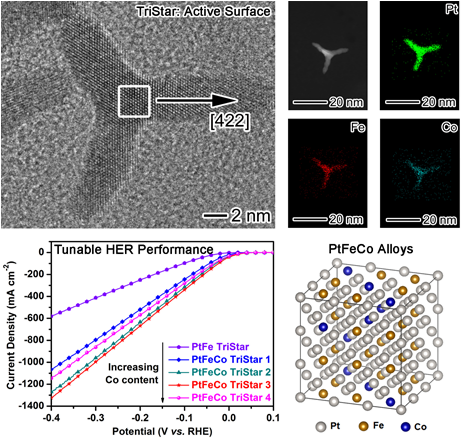The research group led by Prof. XIONG Yujie at the University of Science and Technology of China has developed a new class of Pt-based alloy TriStar Nanostructures with significantly improved performance in electrocatalytic hydrogen evolution reaction (HER). This work was published in Advanced Materials (2016, 28, 2077), and highlighted by Materials Views China (http://www.materialsviewschina.com/2016/03/platinum-base-alloy-nano-structure-three-pointed-star-regulating-performance-of-catalyst-for-new-thinking/).
To meet the increasing energy and environmental demands, various approaches have been developed to produce hydrogen – an energy source with high energy density and minimal pollution. Electrocatalytic HER represents a highly important process for hydrogen generation, constituting reversible hydrogen fuel cell technology. Despite the rapid development on alternative materials, Pt is still the most efficient electrocatalyst for the HER. Reducing the Pt usage and boosting the electrocatalytic performance are always the ultimate goals for electrocatalyst design to achieve cost-effective, high-efficiency hydrogen production.

PtFeCo alloy TriStar nanostructures and their HER performance (Courtesy of XIONG Yujie and Angewandte Chemie International Edition)
To address this grand challenge, the researchers have developed a class of trimetallic PtFeCo alloy nanostructures with controllable compositions and in a unique TriStar shape. The precise control over chemical compositions allows tuning the electronic structures of electrocatalysts. In the meantime, the surface structure enabled by the TriStar shape further enhances the HER activity of samples by increasing the number of active sites and reducing the contact resistance. In particular, the researchers have identified that the Pt81Fe28Co10 TriStar nanostructures, which perfectly combine the surface design with the composition engineering, can achieve current density up to 1325 mA cm-2 at potential of -400 mV. This performance well exceeds that of commercial Pt/C catalyst. The synergistic design demonstrated in this work, which reduces the usage of Pt and boosts HER performance by forming alloys, opens up new possibilities for designing low-cost, high-performance electrocatalysts. It would provide fresh insights into rationally designing the alloy electrocatalysts from a different perspective.
This work was financially supported by the 973 Program, the NSFC, the Anhui Provincial Natural Science Foundation, the Recruitment Program of Global Experts, the CAS Hundred Talent Program, the Hefei Science Center (CAS) Funds for Users with Potential, and the Fundamental Research Funds for the Central Universities.
(School of Chemistry and Materials Science, Hefei National Laboratory for Physical Sciences at the Microscale, iChEM, Hefei Science Center CAS (2015HSC-UP012), Research Department)
Publication link: http://onlinelibrary.wiley.com/doi/10.1002/adma.201504785/abstract